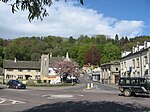Whitstone Hundred

Whitstone was an ancient hundred of Gloucestershire, England. From the 13th century it comprised two adjacent divisions, which included the ancient parishes of: Lower DivisionEastington Frampton-on-Severn Frocester King's Stanley Leonard Stanley Stonehouse Wheatenhurst (now Whitminster)Upper DivisionFretherne Hardwicke Haresfield Longney Moreton Valence Randwick Saul Standish Quedgeley (part)The hundred existed at the time of the Domesday Book in 1086, but covering a smaller area. By 1220 the adjacent Blacklow hundred had been absorbed. Blachelaue in the Domesday Book contained the parishes of Alkerton (now Eastington), Frampton (-on-Severn), Frocester, (Kings) Stanley, (Leonard) Stanley, Stonehouse, Wheatenhurst, and Fretherne.The ancient meeting place of the hundred was probably at Whitestones Field in the parish of Hardwicke, although meetings were later held at Quedgeley, Stonehouse, Wheatenhurst and Frampton.
Excerpt from the Wikipedia article Whitstone Hundred (License: CC BY-SA 3.0, Authors, Images).Whitstone Hundred
Barton Close,
Geographical coordinates (GPS) Address Nearby Places Show on map
Geographical coordinates (GPS)
| Latitude | Longitude |
|---|---|
| N 51.7 ° | E -2.23 ° |
Address
Barton Close
Barton Close
GL6 0LW , Forest Green
England, United Kingdom
Open on Google Maps








